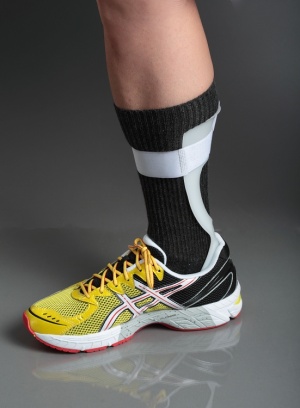Foot drop: Difference between revisions
Abbey Wright (talk | contribs) (Created page with " <div class="noeditbox">This article or area is currently under construction and may only be partially complete. Please come back soon to see the finished work! ({{06}}/{{01}}...") |
Abbey Wright (talk | contribs) No edit summary |
||
| Line 6: | Line 6: | ||
'''Lead Editors''' | '''Lead Editors''' | ||
</div> | </div> | ||
== Clinically Relevant Anatomy | == Clinically Relevant Anatomy == | ||
add text here relating to '''''clinically relevant''''' anatomy of the condition<br> | add text here relating to '''''clinically relevant''''' anatomy of the condition<br> | ||
== Mechanism of Injury / Pathological Process | == Mechanism of Injury / Pathological Process == | ||
add text here relating to the mechanism of injury and/or pathology of the condition<br> | add text here relating to the mechanism of injury and/or pathology of the condition<br> | ||
| Line 26: | Line 26: | ||
add links to outcome measures here (see [[Outcome Measures|Outcome Measures Database]]) | add links to outcome measures here (see [[Outcome Measures|Outcome Measures Database]]) | ||
== Management / Interventions | == Management / Interventions == | ||
Following palsy of the common peroneal nerve the main residual symptom can be foot drop due to the disruption to L4/5 muscle groups which perform dorsiflexion. | |||
This has been shown to resolve in two thirds of patients by one year post injury. <ref name=":0">Park JH, Restrepo C, Norton R, Mandel S, Sharkey PF, Parvizi J. [https://jdc.jefferson.edu/cgi/viewcontent.cgi?article=1067&context=orthofp Common peroneal nerve palsy following total knee arthroplasty: prognostic factors and course of recovery.] The Journal of arthroplasty. 2013 Oct 1;28(9):1538-42</ref> | |||
== Differential Diagnosis | There are methods to improve the foot drop such as: use of splinting in a solid ankle-foot orthoses or foot-up splint. These work to increase the amount of dorsiflexion the foot is held in during gait and can prevent falls as the toes do not get caught on the floor. | ||
[[File:AFO-Swedish-Leaf-Side-Shoe.jpg|none|thumb]] | |||
Ankle-Foot orthoses used for foot drop | |||
Graded exercises to encourage active dorsiflexion has been shown to prevent atrophy and speed up recovery but more research is needed.<ref name=":0" /> | |||
Electro-stimulation of the effected muscle groups has also been shown to improve recovery times.<ref name=":0" /> | |||
In extreme cases tibialis posterior can be transposed to regain active dorsiflexion through surgery.<ref>Baima J, Krivickas L. [https://www.ncbi.nlm.nih.gov/pmc/articles/PMC2684217/ Evaluation and treatment of peroneal neuropathy.] Current reviews in musculoskeletal medicine. 2008 Jun 1;1(2):147-53.</ref> | |||
== Differential Diagnosis == | |||
add text here relating to the differential diagnosis of this condition<br> | add text here relating to the differential diagnosis of this condition<br> | ||
== Resources | == Resources == | ||
add appropriate resources here | add appropriate resources here | ||
Revision as of 11:18, 6 January 2020
Original Editor - Your name will be added here if you created the original content for this page.
Lead Editors
Clinically Relevant Anatomy[edit | edit source]
add text here relating to clinically relevant anatomy of the condition
Mechanism of Injury / Pathological Process[edit | edit source]
add text here relating to the mechanism of injury and/or pathology of the condition
Clinical Presentation[edit | edit source]
add text here relating to the clinical presentation of the condition
Diagnostic Procedures[edit | edit source]
add text here relating to diagnostic tests for the condition
Outcome Measures[edit | edit source]
add links to outcome measures here (see Outcome Measures Database)
Management / Interventions[edit | edit source]
Following palsy of the common peroneal nerve the main residual symptom can be foot drop due to the disruption to L4/5 muscle groups which perform dorsiflexion.
This has been shown to resolve in two thirds of patients by one year post injury. [1]
There are methods to improve the foot drop such as: use of splinting in a solid ankle-foot orthoses or foot-up splint. These work to increase the amount of dorsiflexion the foot is held in during gait and can prevent falls as the toes do not get caught on the floor.
Ankle-Foot orthoses used for foot drop
Graded exercises to encourage active dorsiflexion has been shown to prevent atrophy and speed up recovery but more research is needed.[1]
Electro-stimulation of the effected muscle groups has also been shown to improve recovery times.[1]
In extreme cases tibialis posterior can be transposed to regain active dorsiflexion through surgery.[2]
Differential Diagnosis[edit | edit source]
add text here relating to the differential diagnosis of this condition
Resources[edit | edit source]
add appropriate resources here
References[edit | edit source]
- ↑ 1.0 1.1 1.2 Park JH, Restrepo C, Norton R, Mandel S, Sharkey PF, Parvizi J. Common peroneal nerve palsy following total knee arthroplasty: prognostic factors and course of recovery. The Journal of arthroplasty. 2013 Oct 1;28(9):1538-42
- ↑ Baima J, Krivickas L. Evaluation and treatment of peroneal neuropathy. Current reviews in musculoskeletal medicine. 2008 Jun 1;1(2):147-53.







